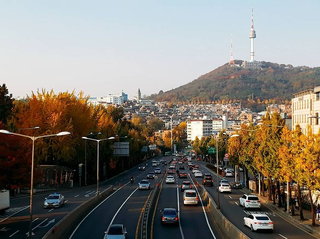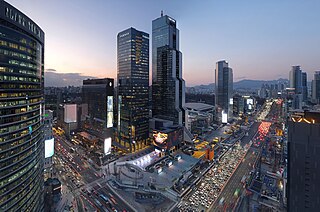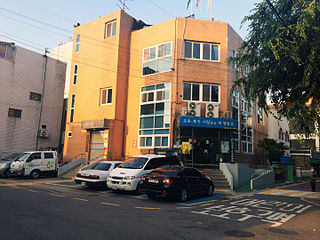
Seongnam is the fourth largest city in South Korea's Gyeonggi Province after Suwon and the 10th largest city in the country. Its population is approximately one million. It consists of three administrative districts: Bundang-gu, Jungwon-gu, and Sujeong-gu.

Yongsan District is one of the 25 districts of Seoul, South Korea.
The primary subdivisions of Gyeongju in South Korea consist of 4 eup, 8 myeon, and 11 dong. These units are the same into which all of the cities and counties of South Korea are divided. The dong units occupy the area of the city center, which was formerly occupied by Gyeongju-eup. Eup refers to a substantial village, whereas the myeon are more rural. The current divisions are as follows, using the numbers given on the map:

Gangnam District is one of the 25 districts of Seoul, South Korea. The term Gangnam translates to "South of the [Han] River". Gangnam District is the third largest district in Seoul, with an area of 39.5 km2 (15.3 sq mi). As of the 2024 census, Gangnam District had a population of 556,570. There is a high concentration of wealth in the district, with prices for an apartment as of 2024 more than double those in the rest of Seoul. Gangnam District is part of Gangnam School District Eight, along with the Seocho District. This district shares half of Gangnam-daero Gangnam Station area with Seocho District, which is one of the most crowded places in South Korea.

Seocho District is one of the 25 local government districts which make up the city of Seoul, South Korea. Seocho is a part of the Gangnam region, along with the Gangnam district of Seoul. Seocho District ranks as one of the richest neighborhoods in South Korea and among the most expensive areas in Seoul with an average sales price of 47.75 million South Korean won per 3.3 square meters. Many of the wealthiest residents are concentrated in the three Gangnam districts including Seocho, known as Gangnam School District Eight.

Pangyo or Pangyo New Town is a planned district composed of several dongs or neighborhoods of Seongnam, South Korea. It contains Pangyo-dong, Baekhyeon-dong, Unjung-dong, and Sampyeong-dong of Bundang-gu and Siheung-dong and Sasong-dong of Sujeong-gu.

Seorae Village (Korean: 서래마을), sometimes nicknamed "Montmartre", due to its hilltop location, or sometimes "French Village", is a small, affluent French ethnic enclave in Banpo-dong & Bangbae-dong, Seocho District, Seoul, South Korea. It is home to about 560 French people, roughly 40% of the French community in South Korea. Most of them are employees of French corporations doing business in the country. The majority (370) of the French population are children.

Seocho-dong is a dong, or neighborhood of the greater Gangnam area Seocho-gu district of the South Korean city of Seoul. Seocho-dong is divided into 4 different dong which are Seocho 1-dong, 2-dong, 3-dong and 4-dong. The main street is Teheranno. There is Gangnam Station in Seocho-dong, which is one of the biggest stations in Korea.

Bangbae-dong is a dong, or neighbourhood of the greater Gangnam area Seocho District district of the South Korean city of Seoul. Bangbae-dong is divided into 5 different dongs which are Bangbaebon-dong, Bangbae 1-dong, 2-dong, 3-dong and 4-dong. The origin of Bangbae-dong is derived from the name Bangbae, meaning "dong-ri with my back to Mt. Myeon-ri," which rises on the border between Gwanak District and Seocho District. Bangbae-dong was Bangbae-ri, Sangbuk-myeon, Gwacheon-gun, Gyeonggi-do until the end of the Joseon Dynasty, but became Bangbae-ri, Sindong-myeon, Siheung-gun, Gyeonggi-do in 1914 when the area was confirmed during the Japanese colonial period. It was incorporated into the Seoul Metropolitan Government following the expansion of the Seoul Metropolitan Government's zone in 1963, and became Bangbae-dong to this day. The location is Dong at the western end of Seocho District, and it is an area from the intersection of the road from Seoul to Gwacheon City and the southern circulation road to Umyeon Mountain.

Jamwon-dong is a dong, neighbourhood of the greater Gangnam area Seocho-gu in Seoul, South Korea. Until 1988, Jamwon-dong was under the jurisdiction of Gangnam-gu. Jamwon-dong is popular for its mulberry trees and silkworms, whose cocoon is used to make fabric for clothing. As a legal-status neighborhood, Jamwon-dong includes Banpo 3-dong and Jamwon-dong.

Banpo-dong is a dong, neighborhood of Seocho District, the greater Gangnam area in Seoul, South Korea. Banpo-dong is divided into five different dong which are Banpobon-dong, Banpo 1-dong, 2-dong, 3-dong and 4-dong.

Yangjae-dong is a dong, neighbourhood of the greater Gangnam area Seocho District in Seoul, South Korea. Yangjae-dong is divided into 2 different dong which are Yangjae 1-dong and 2-dong.
Umyeon-dong is a dong, neighbourhood of Seocho-gu in Seoul, South Korea is part of Gangnam District and a well-known, private neighborhood for the wealthy in southern Seoul. It is a legal dong (법정동) administered under its administrative dong (행정동), Yangjae 1-dong. The first syllable of the name is derived from Umyeonsan, or Mt. Umyeon due to the geographical feature of the area has the mountain.
Sinwon-dong is a dong, neighbourhood of Seocho-gu in Seoul, South Korea. It is a legal dong administered under its administrative dong, Naegok-dong.
Yeomgok-dong is a dong, neighbourhood of Seocho-gu in Seoul, South Korea. It is a legal dong administered under its administrative dong, Naegok-dong.

Yangpyeong-dong is a dong, neighborhood of Yeongdeungpo-gu in Seoul, South Korea.

Hannam-dong (Korean: 한남동) is a wealthy dong (neighborhood)of Yongsan District, Seoul, South Korea. It has been portrayed continuously in South Korea's popular culture as an oasis of wealth and luxury, thus becoming the subject of numerous domestic films, television series, and popular music references.

Seobinggo-dong is a dong, neighbourhood of Yongsan-gu in Seoul, South Korea. It is directly across the river from Banpo-dong, Seocho-gu, with the Banpo Bridge connecting the two neighbourhoods.

Suji-gu (Korean: 수지구), or Suji, is one of the three city districts in Yongin City, South Korea which is approximately 29 km south of Seoul. Suji became a city district on October 31, 2005, about nine years after Yongin officially became a city. When Yongin City was established in 1996, both urban and rural areas were covered to become a part of the city; thus to this day, Yongin's urbanization is varied throughout different regions of the city. Suji is one of the most urbanized areas of Yongin, as it borders Seongnam City's Bundang District and Suwon City, two more well developed areas. Home to the newly built Shinsegae Department Store and Dankook University in one of its towns, Jukjeon, Suji is rapidly developing as Yongin City becomes more and more urbanized. In recent years, the district has attracted upper-class Koreans, with the completion of the Samsung East Palace in 2010.

Jukjeon-dong is a dong in Suji-gu of Yongin city. Jukjeon was divided into Jukjeon 1-dong and Jukjeon 2-dong on December 24, 2001, when Suji-eup was promoted into Suji-gu. Jukjeon borders Seongnam city to the north, Mohyeon-Eup of Cheoin-gu to the east, and Giheung-gu to the south. Tancheon flows through the neighborhood, with west of the stream classified as Jukjeon 1-dong and the east of it classified as Jukjeon 2-dong. Jeongpyeongcheon, a stream, also flows into Tancheon at Jukjeon. Along the banks of Tancheon are small parks and paths for walkers and cyclists.

















